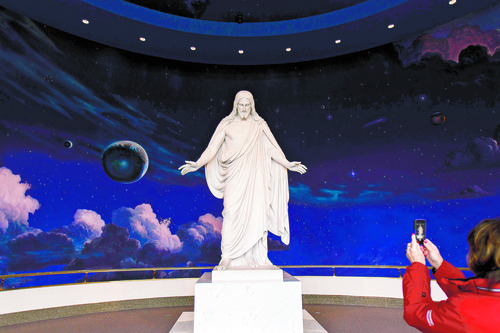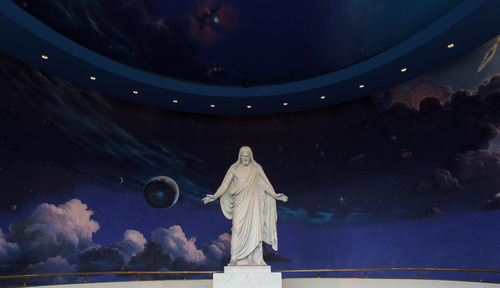This is an archived article that was published on sltrib.com in 2013, and information in the article may be outdated. It is provided only for personal research purposes and may not be reprinted.
On Easter morning, Jesus stepped out of his tomb, so the Bible says, and then lingered among his friends and followers for 40 days. When he eventually ascended into heaven, the man they considered the Son of God assured them he would come back someday.
So those devoted first-century fishermen, fathers, mothers and tax collectors watched, wondered and waited, convinced Jesus would show up by the side of a lake, walking along a road or descending from the sky.
It's been 2,000 years and Christians are still counting on that promised return.
The so-called Second Coming is part of Christian scripture, theology and tradition. It has been celebrated in song (think "Battle Hymn of the Republic"), poetry and art of every era. It either inspires or terrifies many believers.
Jesus said no one will know when he is coming but that hasn't stopped people from trying to read the "signs of the times" for clues. Wars, weird weather, natural disasters, diseases, conflicts, violence have prompted false predictions throughout history — most notably in the 19th and 20th centuries. The consequences of such ill-founded assumptions are real and often painful.
Tens of thousands of Americans were persuaded by Baptist preacher William Miller that Christ would return Oct. 22, 1844, which didn't happen. Many went away dejected, but others regrouped and formed the Seventh-day Adventist Church to preach about the coming Christ — with no specific date in mind.
A century and a half later, Christian radio host Harold Camping attracted a following with his insistence that the world would end May 21, 2011, and then Oct. 21, 2011. Some people gave up jobs, abandoned homes and made no plans for continued existence after those dates and found themselves bitter, lost and embarrassed.
Even still, nearly half of American Christians expect Jesus to return in the next 40 years, according to a 2010 poll by the Pew Research Center. About 27 percent say "definitely," while 20 percent say "probably."
But what if he once again fails to appear? What good is all this anxiousness and anticipation?
Living in the now • Having a kind of deadline, even if it's always in the future, gives an urgency to daily life, says the Rev. Matthew Gilbert of downtown Salt Lake City's Holy Trinity Greek Orthodox Church.
"It's about preparing for eternity," says Gilbert, whose Orthodox Church will celebrate Easter on May 5. "We have to be spiritually ready in every moment."
The message of the Second Coming is to take life seriously, he says, not to procrastinate but to live faithfully in every moment.
The Rev. France Davis of Salt Lake City's Calvary Baptist Church agrees.
"We need to be ready at all times," says the soft-spoken pastor. "We need to be living the golden rule, show love to one another, treat our neighbors the way we want to be treated."
There is no need to fear the end times, Davis says, "unless you are not ready."
The Rev. Mike Imperiale of Salt Lake City's First Presbyterian Church strives to keep his congregation focused on redemption, rather than judgment and anxiety.
"One of my roles is to help people not get wrapped up in the signs of the times," he says. "Those have been around for a long time."
Imperiale doesn't spend much energy imagining Christ floating among the clouds, but he does believe that the Savior will come back in a literal, physical way.
"How that works in terms of physics, I have no clue," the pastor says. "But the Bible gives us enough description to have hope."
How, then, does the promise of Christ's return change the world?
All things new • A vision of the future reveals much about Christian ideals, says Jana Riess, a Mormon convert in Cincinnati who at one point studied to become a Presbyterian minister.
Riess points to a verse in the Bible's Book of Revelation, which describes a new heaven and new earth where God will wipe every tear from human eyes.
"This, to me, is the beauty of imagining Christ's return," Riess says. "It will offer a fullness of creation and an end to suffering — and there is so much suffering — which is a beautiful thing."
Revelation also provides a vision of the end times, she says, when "people from every nation come together to worship the lamb."
Few Christians, she says, emphasize this, but Riess sees it as "hugely important to think that there will be no national, religious or gender divisions."
This new condition, she says, "will provide a unity that we haven't been able to experience in our fallen state."
Mormonism was born in the 1830s, partly as a millennial church, even using the term "Latter-day Saints" in its name. Like other Christians, some members have tried to decode the Bible's clues about the end times, or they expect Christ's return in their lifetime. Periodically, LDS leaders have had to warn their flock not to be overly concerned with the coming conflagration. Food storage is smart and practical; elaborate bomb shelters maybe not so much.
Fears of a looming apocalypse are understandable, given society's declining morals and ever-present temptations to sin, senior LDS apostle Boyd K. Packer said in October 2011, but his generation felt a similar anxiety about the condition of the world.
When he was 17, the Japanese launched a surprise attack on Pearl Harbor. Within a short time, the U.S. declared war on that Asian nation and joined the battles in Europe. He and many other religious young people thought perhaps this might be the end of the world prophesied in scripture.
"All at once our future was uncertain. We did not know what was ahead," Packer said. "Would we live to get married and have a family?"
Young Mormons today may have similar worries about the future, but they shouldn't, the Mormon apostle said. They can look forward to "getting married, having a family, seeing your children and grandchildren, maybe even great-grandchildren."
The more important question than when Christ will return, Riess says, is why.
"What hasn't been accomplished that needs to be?" she wonders. "That's where we have to focus our energy."
An LDS children's song, "When He Comes Again," imagines what it might be like when Jesus returns. Will it be winter or spring? Will he gather children around him, will he recognize their devotion and goodness? Will he embrace them?
That's looking away from fear in Christ's presence, Riess says, to love.
Facebook: peggy.fletcherstack
Twitter: @religiongal —
'When he comes again'
I wonder, when he comes again,
Will herald angels sing?
Will earth be white with drifted snow,
Or will the world know spring?
I wonder if one star will shine
Far brighter than the rest;
Will daylight stay the whole night through?
Will songbirds leave their nests?
I'm sure he'll call his little ones
Together 'round his knee,
Because he said in days gone by,
"Suffer them to come to me."
Source: LDS.org, "When He Comes Again," by Mirla Greenwood Thayne, 1907–1997 —
Bible predicts Second Coming
"For the Son of Man shall come in the glory of his Father with his angels; and then he shall reward every man according to his works."
Matthew 16:27
"And while they looked steadfastly toward heaven as he [Jesus] went up, behold, two men stood by them in white apparel;
"Which also said, Ye men of Galilee, why stand ye gazing up into heaven? This same Jesus, which is taken up from you into heaven, shall so come in like manner as ye have seen him go into heaven."
Acts 1:10-11







